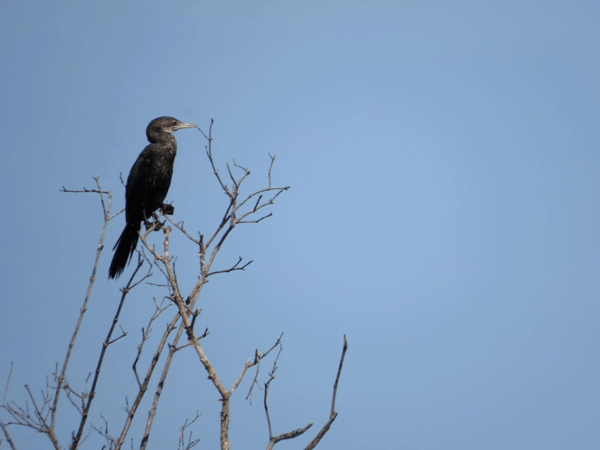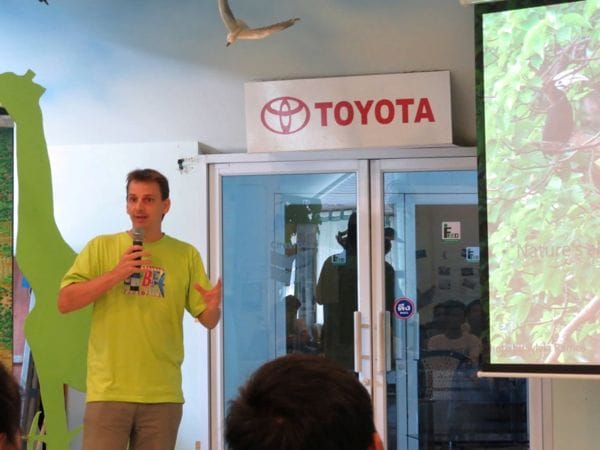by Willem van de Ven
WBCP Vice President Willem van de Ven and WBCP Treasurer Mike Lu represented the club at the 13th Thailand Bird Fair.

In the first week of November, Mike and I travelled to Thailand to have a taste of mainland cuisine, experience Thai hospitality and enjoy the sight of all kinds of exotic lifers such as Oriental Magpie Robins and Pied Fantails, while being sucked dry by hordes of mosquitoes. We also got a chance to mingle with hundreds of people feeding pork to Gulls, and… oh yeah, represent the Philippines and the WBCP at the Thailand Bird Fair. We managed all of the above, though we had to squeeze in the whole representing and booth standing part as we were kept fairly busy with all other things going on.
The theme of the Bird Fair was ‘love birds, save habitats’ and one of the species chosen to represent this in the logo was the Wreathed Hornbill (Rhyticeros undulatus), a widespread colorful forest-dwelling species. Thailand has in fact one of the highest number of hornbill species in the world, with 13 species residing in the country.
Thailand, undoubtedly because they are up to date and in touch with Filipino culture, made sure we took it easy from the moment we arrived on Bangkok airport; a long line stretching half the airport just before customs, enabling me to take in the sights at the terminal and Mike the opportunity to hone his dormant photography skills. Once cleared of Ebola suspicion and loaded with luggage, we then proceeded to wait for a few hours for some other delegates, who had already left the airport. The road system in Thailand is great; we could not have had a smoother ride going south from the airport, and in fact both of us fell asleep several times, only to wake up gawking in wonder at the city and the birds and wildlife right next to the highway. At first I thought I must have been mistaken, however twice I saw a monitor lizard, which must have been more than a meter in length, swimming the canals of residential areas, in between cormorants and egrets basking in the trees. Not hunting your wildlife certainly makes it easy for the nature enthusiasts! We couldn’t resist going out in the evening before the welcome dinner (great mounds of vegetables, shrimps and unidentified but tasty dishes) to check out the different Mynas (we saw three species right outside the hotel), and were quite as exhausted from this day as we were as excited for the next when we went to sleep that night.

Although Thailand has 13 species of Hornbills, none of those are endemic to the country, and most are in fact reasonably common; quite a difference from Philippine hornbill species; we have 10 species, all of which are endemic to our country, and most are threatened to some degree.
The Bird Fair itself started early morning the day after, with lots of scrambling around and amicably fighting for a ladder to hang the tarpaulins. MNS had set up their booth right next to us and provided coloring plates for kids and for us during the hot hours of the early afternoon. On day two of the fair I gave a presentation about Philippine hornbills and the threats that are facing them. The venue was set at Bangpoo, in the province Samut Prakan, in a mangrove area ending on a pier where the booths were set up and where hundreds of people come every day to feed, and take selfies with, a large congregation of gulls. The area boasts a tract of mangrove forest with several ponds, crisscrossed bywalkways, hides, wooden walkways through the marshes, observation towers and even a canopy walk. One advice; bring mosquito repellant! A downside of these easy access places for enjoying nature is the fall of a friend to the dark side; Mike has taken up bird photography with an enthusiasm rivaled only by his gusto as the WBCP treasurer.

I gave a presentation mostly containing photos of Philippine Hornbills in the wild, to show off their magnificence and show the world that hornbills are unique and worth saving. Hornbills are not only beautiful; they are also an integral part of the ecosystem, playing an important role in seed dispersal.


The dinners were always superb; I like the fact that rice seems to be a dish instead of the dish; the table was groaning under the weight of heaps of vegetables, tureens of spicy soup and platters of fish. It seemed that specifically for the foreign palate, unaccustomed as we are to eye-watering food, they were slowly increasing the amount of peppers with every meal, and in fact on the last day we were both chewing on jalapenos for after dinner snack in order to enhance the cooling effect of sticky rice with mangoes for desert.

Hornbills in the Philippines face several threats; not least of which is hunting for food, for sport or for collections. They are large, colorful and conspicuous; making them easy prey and in much demand. However, still the main reason for the decline of hornbill populations throughout the country is the destruction of their habitat; lowland forest. If we want to save these magnificent animals from extinction, we will have to stick to the motto of the Thailand Bird Fair, and love birds, save habitats!
Everything was wonderfully organized by the Bird Conservation Society of Thailand (BCST) and we are very grateful to our hosts, especially Armorn Liukeeratiyutkul and Pinit Saengkaew. After the Bird Fair we still had one evening in Bangkok, in a hotel which was incredibly beautiful, perhaps it is a former palace of the royal family, and thus we enjoyed the evening chatting with friends seated on poufs or on the floor. Too bad we never got around to experiencing the famous Thai Massage…


Pingback:January 2015 | e-BON